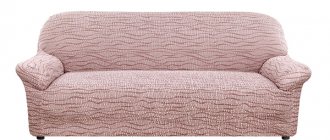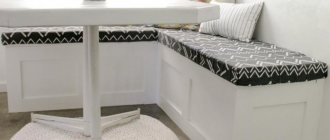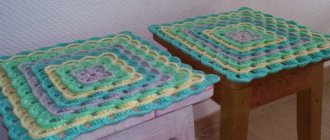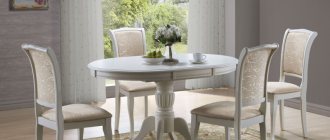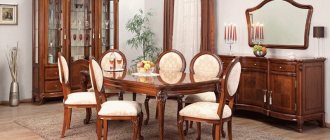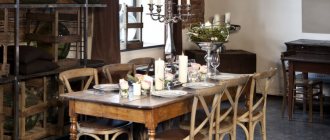Options
There are quite a few options for covers, but among them there are several main ones.
- Seat cover - such a cover will protect the original upholstery from dirt and prevent rapid wear.
- A half-cover is a product that does not completely cover the chair.
- Another option is separate covers for the back and seat. The back cover is great for the holidays; unlike other options, this one is the easiest to sew.
And finally, solid covers that cover the entire surface of the chair, hiding absolutely all defects. But in terms of tailoring, it is a rather complex product that requires the most materials and time to manufacture.
Measurements and pattern
In order for the pattern to be accurate and the product to fit well, you must first take measurements.
We take measurements. Depending on the model of the cover, you need to measure the height and width of the seat and back, as well as the estimated length of the product. Pay special attention to the measurements of the chair legs, as in some models they may widen downward. In this case, you need to take several measurements at the top and then at the base of the chair.
We mark the widest and narrowest areas in our drawing.
- Drawing. Before transferring the measurements taken to the pattern, draw a drawing on paper and mark all the measurements taken there. The simplest pattern is for a one-piece cover: it simplifies sewing, but requires a little more fabric than cutting all the parts separately.
- Pattern. After that, we proceed directly to the full-size pattern. It can be built on tracing paper, newspaper or leftover wallpaper, repeating the schematic drawing.
- Checking the pattern. To be completely sure that the pattern is correct, apply it to the chair and secure it with tape. This way we can see all possible inaccuracies made when constructing the drawing and correct them before sewing begins.
- Final version. Then we build the final version of the pattern - with seam allowances (about 2 cm on each side).
Fabric selection
The main criteria are functionality and stylistic combination.
In addition, it should match the curtains and tablecloths. It is recommended to buy covers with fabrics that are pleasant to the touch; they are perceived differently by people, so an individual approach is needed. It is important to pay attention to the ability of the material to maintain high quality after washing and be resistant to stains (depending on the color).
There are about 6-8 commonly used types of fabrics.
- Gabardine has a dense structure.
- Synthetic materials are worse in all respects: they quickly get dirty and dry out.
- Crepe-satin is elastic and soft, quite thin and has a shine.
- Lycra (supplex) is elastic, looks beautiful, and is easy to care for.
- Spandex does not allow water to pass through, but breathes well, so it is durable.
- The brocade is heavy , thick and looks expensive. It is difficult to care for, so it is better to use dry cleaning services.
Selecting a case by style
When choosing a cover, it is important what shape and texture will suit the style chosen for the room.
- If you are a follower of natural styles (Country, Provence), straight-shaped cotton covers, preferably in light, natural colors, as in the photo, are suitable.
- Eco-style – Boho – has become widespread for kitchen interiors. You can support it using covers made of rough burlap (option in the photo) or even denim. They look harmonious with natural wood.
- For lovers of classics, noble fabrics in calm tones (not necessarily light) will suit: crepe-satin, silk, satin, brocade. They always look elegant and aristocratic.
- Modern trends in high-tech style also allow for elements such as chair covers. The main thing is to use them to simplify the shape of the chair and give it geometricity. The fabric for covers in this style should not wrinkle. For example, dense two-layer viscose or supplex.
Covers with flowers and fringe for chairs
Casual and formal covers should differ in both fabric and shape. It would be more logical to have a straight cut for the former and a complex cut (ruffles, frills, bows, ties, ribbons) for the latter. But, in both the first and second cases, in order to maintain harmony in the room, you need to select them to complement the curtains and tablecloth. They may not completely repeat the forms, but include overlapping elements. When choosing fairly bright chair covers and calm tablecloths and curtains, you can smooth out the dissonance with bright accents on the table (napkins, dishes, candles) and windows (tucks, pendants, holders).
How to take measurements from a chair correctly
As in most cases, the first measurement is taken along the longest side - the height of the chair. If necessary, the length of the cover can be adjusted. After this, the height from the floor to the seat is measured. If the base of the chair is solid, without legs, then the sides are measured, and if with legs, then the distances between them, taking into account their own thickness.
Measurements should be taken at the widest point, usually near the floor.
Many people make the mistake of measuring the backrest in width and height between the frame - you need to find out the full parameters. You need to measure the seat in a different way. If it is raised relative to the level of the frame, then the readings are taken along the boundaries of the seat. And if at the same height, then along the edges of the entire structure, but if you need to sew a cape only on the seat, then it is better to measure only the soft part.
A seat of this size will be enough for comfortable sitting.
Drawing and transferring the pattern to fabric
The paper is applied to the seat of the chair, secured with tailor's needles and traced around the edges. Make a reserve of about one and a half centimeters for allowance. Next, the part is cut out.
The pattern from the back is done in the same way.
Then a rectangle is drawn on the sheet, corresponding to the length of the legs and the width of the seat at the front of the “skirt”, and 10 cm of the pattern on the side, 5 cm at the bottom and 1.5 cm allowance for the top seam are added to it. The sides are drawn in a similar way. 15 cm is added to the edge next to the outer part of the back. A long, wide sheet is applied to the outer part.
- In the drawing of the back legs of the chair, 5 cm is added at the bottom and 1.5 cm for the allowance.
Patterns are smoothed out because any unevenness will interfere with sewing. Next, the drawing is transferred to the material, taking into account the position of the shared thread. You can draw on fabric with a pencil, a bar of soap or chalk. The pattern is made in two samples.
Trying on and sewing tips
When the drawings have already been prepared, all that remains is to make the layout and find out the material consumption. When sewing chair covers, an optical illusion occurs, as if only a little fabric is needed. Seams and decorative elements (ruffles, folds) “require” an additional amount of material and forethought from the craftsman.
Beginners will need an “experimental” case.
The pattern is placed on a perfectly flat surface. Dimensions are double-checked vertically and horizontally. Allowances are made along the edges. After eliminating all the shortcomings, shapes are cut out of the fabric with scissors. Trying is carried out several times. Based on its results, adjustments are made. If necessary, the workpiece is ripped apart, and again you will need to create a “test” cape.
The product should take on its final form after it exactly matches the contours of the chair.
The cut is sewn on a sewing machine. It must be borne in mind that the parts must be placed in the direction of the grain thread. Straight covers will fit better if their seams are equipped with zippers.
Using a ready-made pattern, you can practice and make patterns, fitting and sewing a cover for a certain type of chair.
Which option to choose
You can buy covers, however, it is much more interesting to create them yourself. To sew one cover you will have to spend about 1-2 meters of fabric.
If you don’t have sewing skills, then you can turn to professionals who are ready to create a unique version of the case. They will be happy to create the required product after listening to the customer’s wishes.
Decor for a large company
If you are setting a table for a large company for the New Year, you can attach a Santa Claus hat to each chair on a clothespin - when sitting down at the table, guests put them on and become part of the holiday. And if there is a gift in store for each guest, then you can put it in a New Year’s sock, and in turn attach the sock to the back - what a homemade decoration! You can do the same with sweets and tie, for example, a sweet New Year's stick to the back. Guests will love it if paper ribbons or cookies with their names hang on the back along with the decor. You can see inspiring photos and decor of chairs for a large company below.
For originals. New Year is another way to stand out. Among the original design options, we like the decor with fluffy wings, elements of winter clothing with appropriate paraphernalia (children's mittens with a spruce branch inside look very cute), as well as special covers for chair legs in the form of elf legs, little helpers of the overseas Santa Claus.
If you have the right talents, you can sew them yourself. Some even hang winter skates on the back of their chair! Another technique that we have long come to love is cones. It’s easy to find them either in markets, or in the countryside or in the forest, so why not decorate the back of the seats? This is where you'll need ribbons again, and don't forget your sense of style!
Thanks to many years of traditions in our country, we usually celebrate the New Year at the table with our loved ones. First, saying goodbye to the old year, and only then welcoming the new year, in total we spend a lot of time at the table, and therefore serving, decorating the table and chairs with the help of scrap materials and homemade decor easily create a festive mood for us. We hope that our tips for decorating chairs will be useful to you and that all the wishes that you make while sitting on them will definitely come true!
Choosing fabric for sewing
Sewing can be done from a variety of materials. It all depends on the final purpose of the cover. For daily use you need a practical and inexpensive fabric, and for the holidays you need a beautiful and elegant one.
In addition, they take into account the room in which the chairs are located, its purpose and its own interior.
Important! For everyday use, you should choose a wear-resistant material that can be removed and washed or knocked out at any time. One of the criteria is also the absence of electrification and absorption of contaminants. Some of the best fabrics for sewing are considered to be cotton, microfiber, linen or silk.
Cotton fabrics
Among them, the priority is satin, calico, denim or twill. Their key advantage is that they hold their shape well, do not cause allergies in sensitive people and are machine washable. Cotton fabrics are inexpensive and come in a variety of shades, colors and patterns.
They also have disadvantages : rapid fading and getting wet.
Linen fabrics
These include matting, linen itself and canvas. They are environmentally friendly, highly durable, dirt-repellent and can be subjected to intensive machine washing and intensive use.
Also, linen does not absorb dirt well, it is hypoallergenic and easy to care for.
Rough, minimally processed linen fabrics are ideal for everyday slipcovering. The disadvantages are: difficulty in cleaning and ironing, rough texture. Linen covers are suitable for everyday use in country or ethnic style rooms.
Flock and microfiber
These materials are new generation materials. Their main advantages were:
- Wear resistance;
- Attractiveness;
- No creasing;
- No deformation when washing.
Important! Despite this, microfiber and flock cannot be subjected to heat treatment: dry on a radiator and iron. This is not necessary if there is no creasing.
Silk
Silk fabrics include: brocade, satin, crepe-satin. Their advantages are that they are durable, noble and resilient. Silk fabrics make it possible to create spectacular folds and draperies. There are also disadvantages: high price, demanding care and washing, careful ironing.
Such canvases are suitable for creating holiday covers in classical and neoclassical, Indian and Arabic styles.
Step-by-step instructions on how to sew a cover for a chair with a backrest
You can order tailoring from purchased fabric from a craftsman, but it is much more profitable and enjoyable to do it yourself. The only caveat: all measurements must be accurate and take into account seam allowances and fabric shrinkage when washing.
For this, one or one and a half centimeters should be enough.
To get started, you need to prepare all the necessary materials and tools:
- Threads and needles;
- Sewing machine;
- Adhesive tapes;
- Scissors and awl.
Step-by-step manufacturing instructions are as follows:
- Make a pattern on tracing paper or film that will fit well on the furniture to take all measurements;
- Cut out a seat from soft synthetic padding and make allowances of 1 cm at the edges and 3 cm at the back;
- Attach the padding polyester to the seat and measure out the recesses for the legs at the back. Cut notches along the contour;
- Determine the height of the cover and, leaving the bottom of the furniture open, measure the sides and back wall of the chair;
- Transfer the pattern to the selected material and cut it out, not forgetting to leave allowances for seams and shrinkage;
- Round the corners on the sides for a better “seat” of the cover;
- Sew all the parts together using a sewing machine. Make notches on the rounded edges to avoid wrinkles in the fabric;
- Sew decorative elements in the form of braid or beads around the perimeter of the seat;
- Try on a chair cover;
Soft patchwork style seat for chair or stool
Description
We decide on the dimensions of the product. We select multi-colored scraps.
We draw a pattern of the required diameter and divide it into sectors. Using the pattern of a separate sector, we cut the required number of elements.
We lay them out on a horizontal surface, arranging them by color.
First we sew two elements together.
Then we sew the pairs together, getting two semicircles.
Then we make the last seam and get a sewn patchwork circle.
Using it as a template, we cut out a similar part from padding polyester.
Having retreated 3-4 mm in both directions from the joining seams, we perform a contour stitch along the faces. side.
On the inside on the side these seams look like this - see photo.
We cut out a solid round piece for the bottom lining.
We cut out four ribbons to secure the soft seat on the chair.
We bend the short edges of the ribbons inward, fold the fabric in half and stitch.
The process is shown step by step in the photo.
We cut a strip of fabric equal in length to the circumference of our seat plus seam allowances. The width of this strip should be equal to the height of the product plus seam allowances. We attach strings to this strip. We sew a strip between the top (patchwork) and bottom elements.
At the same time, we leave a small area unsewn, making a gap in the seam. We turn the seat out.
We fill it with filler. Sew up the gap by hand using a blind stitch.
Next, let's start making a decorative button. Cut out a circle of small diameter from a suitable fabric. We sew the finished button on the leg. For beginners, the entire technology is shown step by step in the photo of the master class.
We sew a button into the center of the seat, stitching through the entire thickness of the product. Sew a small button on the bottom side. The second button is needed to prevent the fabric from tearing when the threads are pulled.
The soft seat is ready!
Similarly, you can sew a cover for a round stool. It can be decorated with a frill around the perimeter.
Options that are easy to use
Let's look at all the options that you can easily do with your own hands. All the nuances and step-by-step implementation are below.
We sew a cover for a chair with a back
After we have measured the height of the back, legs, and width of the chair, we make a pattern of three elements: rectangles covering the sides and the back with the seat. Don't forget to add a couple of centimeters to the seams.
- Transfer the pattern to the fabric. Since we are dealing with rectangular parts, you can use a ruler for greater accuracy.
- Carefully cut out all the details, taking into account the shared thread.
- First of all, we sew the side edges.
- Then we move on to the side and bottom sections of the back of the back. They should be folded and then stitched.
- Sew the side parts to the seat.
- We tuck and stitch the sections of the side and front parts of the product.
- Ready-made covers can be decorated with a bow or other decor on the back of the chair.
Are you sewing for the first time and doubt your abilities? Try making a test piece first from inexpensive fabric, or at least basting it by hand.
We sew a simple seat
The easiest option, which is suitable even for beginners, is a regular stool seat. It's fairly quick to sew.
- We make a template from cardboard or other material according to the shape of the stool seat;
- using the resulting pattern, we cut out three parts of the same shape and size from the fabric (for the front, back side + padding polyester);
- We place the padding polyester between two pieces of fabric and secure it with pins;
- to quilt the future seat, you need to sew even lines parallel to each other;
- we baste the pre-prepared bias tape for edging, leaving the ends as future ties;
- We carefully fold the ties in half and stitch them on a typewriter;
- We sew bias tape on the sides of the product using a machine.
If you plan to sew several identical covers at once, you should cut them all at once. This will save fabric.
Elastic cover for a round stool
Such an accessory can be sewn even from a small piece of fabric.
- First, as usual, we make a pattern. In order not to bother with measuring instruments when calculating the diameter, you can simply attach a sheet of cardboard or newspaper to the surface of the stool, then cut it along the contour.
- We transfer the drawing to a new sheet of paper, adding a few centimeters along the contour.
- Based on the resulting template, we cut out the piece from the fabric.
- We put an elastic band on the edge of the fabric, fold the fabric, and stitch it.
- Our cover is ready - all that remains is to put it on the stool.
- To add softness, you can sew foam rubber or padding polyester into the seat.
Crochet chair covers
A knitted cover can be an interesting option for decorating a room. Crocheting will take more time than sewing a simple pattern, but the result will be a special and original item.
Crocheted furniture will look especially cozy in winter, as it creates an atmosphere of comfort and warmth.
Most often, round or square models are crocheted for seating stools. Let's look at an example of knitting a simple round cover:
- We make the upper part from rows of lush columns, separated by short chains of air loops.
- We make the hem by knitting several rows in stitches without adding. This way they will form an even side (for greater stability we make the side higher).
- In the last row we knit air loops - at the end you can insert a fixing elastic band or cord into them to secure the product to the stool.
Using various knitting patterns, you can knit absolutely any model with your own hands. For example, the so-called flower cover or models crocheted from motifs (they can also be decorated with crocheted flower appliqués).
There is no need to be shy in choosing bright, rich colors. Multi-colored knitting threads can add originality and enliven the interior.
Cover made from an old sweater
If knitting is not your thing, but the beauty and comfort of knitted covers haunt you, try making them from an old sweater. Any item of the desired size and color, knitted with knitting needles, large or medium knit, is suitable for this.
The edges of the sweater must be carefully processed so that the resulting item does not unravel in the future.
Depending on the size of the sweater, you can sew a cape only on the seat or on the back, or you can get a whole accessory, for example, by using several old products.
Large volumetric patterns in delicate bed colors look especially atmospheric.
Knitted items can stretch, so it is better to make them 1-2 cm smaller in width or diameter.
You can also sew models not only from knitwear, but also from other old things in good condition. For example, from jeans or coats that have become too small. The main thing is that the style of the resulting product matches the interior of the room.
On a children's chair
Chair covers in a children's room are more relevant than anywhere else. Bright, elegant fabrics can decorate the interior of a nursery and interest little fidgets. In addition, they are indispensable in protecting furniture from dirty handprints, spilled drinks or traces of children's creativity.
When sewing such accessories for the nursery, you can give free rein to your imagination: images of cartoon characters, funny animals, flowers, cars, princesses - everything that the child will be incredibly happy about.
The product is sewn according to a standard pattern, as for a regular stool. All measurements are taken in advance. Very often, for children's furniture, capes are sewn only on the back: two rectangular pieces are cut out and sewn in three places. At the end, you can apply a design or decorate it with fabric, sew on “bunny ears” or, for example, design it in the shape of a snowman.
On the inside, so that the cover does not slip, you can sew decorative laces that will be tied behind the legs of the stool. You can also use buttons, ribbons or elastic.
Sewing chair covers in a specialized studio
As mentioned above, you can entrust the work of selecting and sewing covers to a design and interior studio, of which there are now a huge number. There they will offer you options, apply them to a specific case, sew them together, and alter them if necessary. The cost of the work is negotiated initially, as additional difficulties may arise, and it will unpleasantly change upon completion of the work.
The work of selecting and sewing covers can be entrusted to a design and interior studio
Fashionable covers for chairs in the dining room
An interesting option for chair covers
Chair covers for dining room
Unusual drapery covers for chairs
Patterned slipcovers for the dining room
Pink chair covers for the kitchen
Of course, if the financial side of the issue is not an issue, it is better to entrust the matter to a professional. They will take into account your wishes, give advice and complete the work efficiently and in the shortest possible time. To avoid poor-quality work, do not contact unverified studios. These are studios without a portfolio and regulatory information, except for a sign.
Interior style where chair covers are appropriate
Chair covers for the dining room, kitchen, and children's room look most organic. In order for the covers to fit perfectly into the design of the room, you need to take into account the design features and color palette of the textiles.
Provence
Romantic style always remains popular.
Many people like soft natural shades (pale pink, blurry lavender, blue, light green). Characteristic features of this interior trend: textiles with small floral patterns, decorating furniture with knitted and sewn products (tablecloths, covers).
Designer textiles in the Provence style (tablecloths, curtains, napkins) are decorated with ruffles and lace.
At first glance, the interior may seem shabby, and things old and abandoned. However, vintage antiques are not without sophistication. Openwork tablecloths, chair covers decorated with lace, decorative vases, and cute trinkets look elegant in the setting. The color palette is based on light shades.
Warm beige, faded pink and blurry pearl gray tones will add tenderness to the interior.
Country
The color scheme of the style is based on natural shades (milky, beige, light brown). Accents are emphasized with contrasting tones (gray, black, burgundy, bottle green). A balance of opposite colors must be maintained. Wooden furniture of simple shapes and forged products are welcome.
Natural fabrics (linen, tapestry) fit organically into the decor. Textiles with large floral patterns or checkered patterns bring home comfort to the room.
English style
The interior with an English character is the embodiment of elegance and restraint. The stiffness of the setting is softened by textiles with floral prints or small patterns. Furniture upholstery uses both soft plush or exquisite leather, as well as chintz with a printed pattern.
A combination of materials with large and small prints is welcome. To furnish the room, select dark or light products from oak, pine, and mahogany.
American style
The multinational peculiarity of the country is reflected in the interior of the premises. The design mixes and harmoniously combines Oriental, European, and African decorative features. Furniture is most often placed in the center of the room, so an island or peninsula is the hallmark of an American-style kitchen.
Most often, bar stools with high legs are used indoors. Common colors are shades of beige, olive, and white.
If you decide to transform yourself
“My home is my castle,” and making it comfortable is always very pleasant. We rejoice by rearranging cabinets or shelves in a room, replacing old furniture with new ones, etc. If you need an influx of positive emotions, try sewing chair covers yourself. No one claims that you will succeed the first time or that the result will immediately please you. Your surprise will be limitless when you realize that you can decorate your home without anyone else's intervention.
If you need an influx of positive emotions, try sewing chair covers yourself
Choosing fabric
When choosing fabric, you need to start from the purpose of the cover: everyday or festive. For the first option, it is advisable to sew capes from durable, easy-to-clean or waterproof materials, while taking into account the abrasion of the threads.
And for celebrations, you can look for removable furniture accessories made of shiny fabrics.
Cotton
The fabric is a budget option. The material quickly fades due to frequent washing and bright light. However, it is hypoallergenic, easy to wash and ideal for covers on children's or kitchen chairs.
Silk
The fabric is best suited for decorating a formal setting. Intricately cut slipcovers can decorate the furniture in the dining area for a festive lunch or dinner.
Biflex
The material is both dense and elastic, stretches well in any direction. Supplex does not wrinkle, is easy to wash and dries quickly. This is a universal option for office chair covers.
Flock and microfiber
Fleecy fabrics are pleasant to the touch, look like suede, are practical, and at the same time they are much cheaper. Excellent performance qualities allow us to sew European covers for high chairs in the dining room and kitchen.
Caring for fabrics is simple - stains can be removed with detergents.
Organza
The refined and airy fabric holds its shape well. Organza covers are an ideal option for decorating furniture at any special event. Transparent capes do not wrinkle. It is easy to create a product with curvy shapes or with original folds.
Spandex
The stretchy fabric is sold at affordable prices and is great for chairs in any room. Ideal for decorating furniture in banquet halls.
Gabardine
The fabric is quite thin, but elastic. Since the composition of the fabric can be different (cotton, wool, silk), it can be used to sew kitchen covers or elegant capes for living room furniture.
Materials and tools
The fabric for chair covers is selected depending on the purpose of the furniture. Inexpensive textiles that are easy to wash and iron are suitable for the kitchen:
- Cotton: calico, teak, satin. It is advisable to duplicate thin material with double thread or a layer of non-woven fabric, so it will hold its shape better.
- Linen looks great due to its texture, but is difficult to iron.
- Fabrics containing synthetic fibers: polycotton, gabardine - wrinkle less and are easy to wash.
Drawings and procedures for assembling a step stool with your own hands
If we talk about new products, you can pay attention to supplex - elastic knitwear. It easily adapts to shape, does not accumulate static tension, and dries quickly. In addition, this material comes in bright colors, so suitable for the kitchen.
In the living room, chair covers are made from fabric that matches the rest of the textiles:
- jacquard, tweed, velor, flock - they have a rich texture and hold their shape well;
- corduroy and denim are appropriate in a modern interior or a teenager’s room.
Decorating halls for a wedding or other celebration involves elegant, well-draped fabrics. Flashy but inexpensive materials are suitable, since the case will be used for several hours. Optimal options:
- satin and silk are slippery, shiny, flowing fabrics that require lining and reliable fastenings;
- crepe-satin, gabardine, knitwear - their texture is more restrained and allows you to create beautiful frills and draperies;
- taffeta, veil - used to create airy flounces and lush bows.
Moms take different paths when choosing fabric for a highchair cover. Those who need practicality take waterproof materials, others value the baby’s comfort, and still others find a universal but expensive option. Each of them has both advantages and disadvantages:
- Eco-leather - oilcloth-based fabrics are easy to clean and are not afraid of spilled milk. But they are not hygroscopic - in the hot season the child will sweat.
- Velor and knitwear are soft - pleasant to the touch, but they will get dirty, and the cover will have to be washed often.
- NANOtex is a material with microparticles of silver with a water-repellent effect, breathable, does not cause allergies, spilled liquid can simply be blotted with a napkin.
Before cutting, the fabric must be wet-heat treated so that the finished product does not shrink. This is especially important for linen and cotton.
Additional materials that may be needed when sewing:
- lining fabric;
- padding polyester or padding polyester;
- fastenings and fasteners: elastic band, Velcro tape, buttons or zippers;
- braid, fringe, lace and other decorations.
In addition to the sewing machine, you will need: a measuring tape, a marker, scissors, pins and thread.
NANOtex
Velveteen
Denim
Jacquard
Linen
Cotton
Decoration options
The style of the interior in which the chair will stand dictates the methods of decoration. Laconic minimalism or modernism do not tolerate overload, but will accept a combination of fabrics by color or texture, discreet details: pockets, folds.
To decorate cases in a classic interior, the following are suitable:
- long frills;
- edgings emphasizing the clarity of the form;
- thin golden or woven braid;
- imitation of antique lace.
This trend is generally characterized by ceremonial decor and regular geometric shapes.
Rustic style, country and Provence suggest natural fabrics and very cozy finishes:
- frills, ruffles;
- crocheted lace;
- braid with ornament;
- lacing.
In banquet halls, chair covers with backrests are decorated according to the general style of the room. Beads, satin ribbons, rhinestones, and brooches are used for decoration. Artificial or fresh flowers will also come in handy.
Such “clothing” for furniture will protect new chairs and stools from dust and damage, and will give old ones another chance.
In addition, hand-made chair covers will add comfort and beauty to your beloved home. And if you create several sets, then with their help you can update the interior every season.
Shape of chair covers for the kitchen
Also, the functionality of the room is supported by the shape of the covers.
- Covers that fit tightly on the chair are suitable as permanent ones. They fit well, do not get in the way when sitting, are difficult to remove, which means they will protect the chairs from damage as much as possible.
- The loose fit of the covers is very comfortable. In this case, it can be put on a permanent cover, completely covering it. A cover is placed on the chair frame if there are no other covers or, taking advantage of the moment, you decide to wash others. Often, loose covers become a decoration for the kitchen during a celebration: they look elegant, and can be changed very simply and quickly.
- Drapery (throwover) covers can hide partial defects of chairs or add comfort to them. If the chairs are beautiful, but the seats spoil the whole look, you can sew covers only for the seats. If the seat is hard or the shape of the back is uncomfortable, make covers with a foam rubber or orthopedic layer.
Drapery covers for kitchen chairs
Stylish drapery covers for dining room chairs
Original chair covers
When choosing fabric for kitchen covers, you need to take into account density and strength, because they will have to withstand considerable load and washing.
- Interior solution
The interior of any room is created by details. They either act as specific accents of the room, or are integrated completely, creating additional comfort and harmony. Chair covers are now in fashion, but for now they can be found more often as details of holiday decor.



